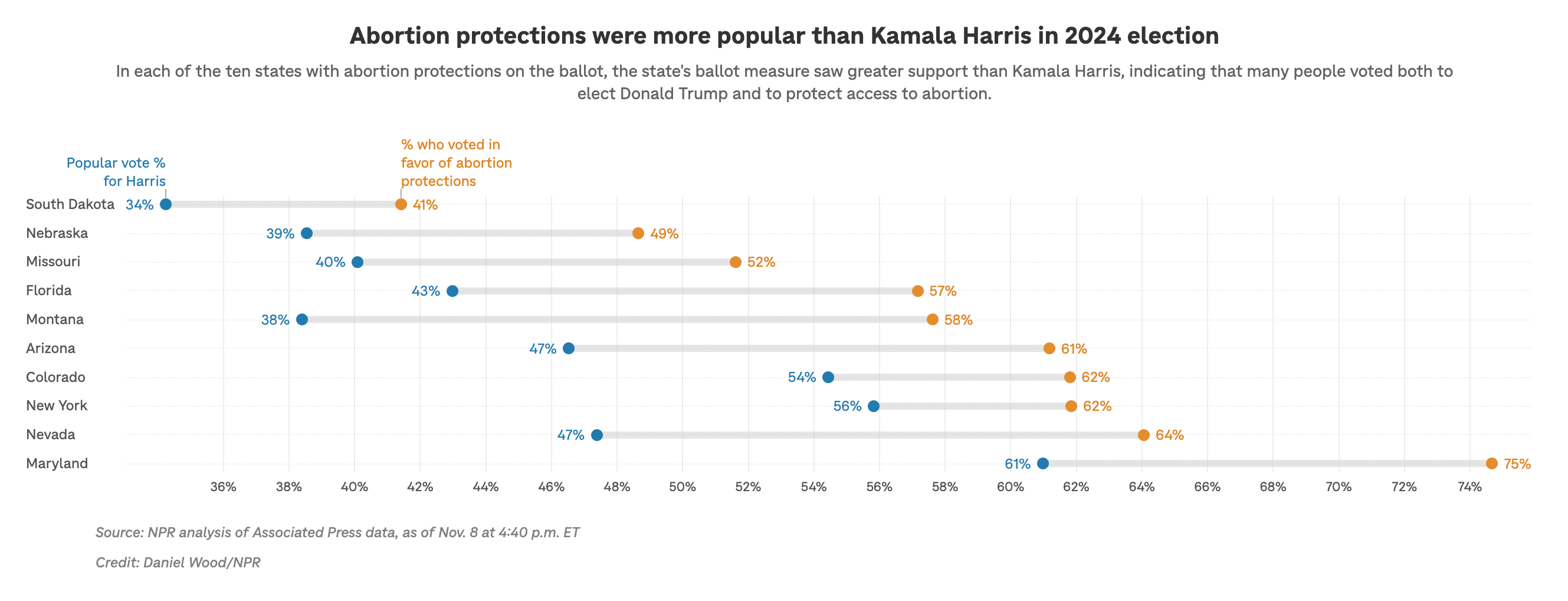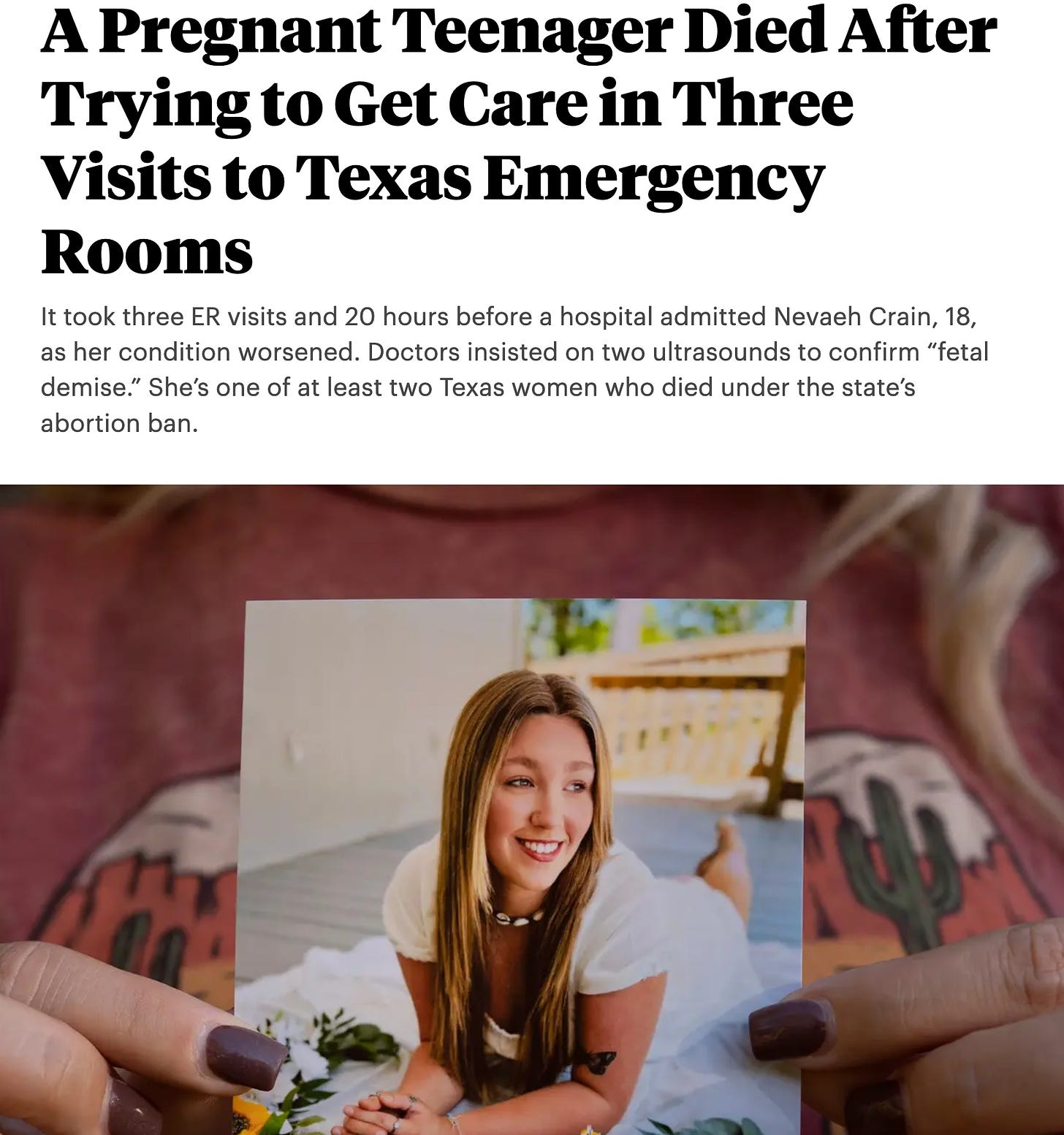Legal Abortion Protections Aren't Enough
What Trump's attack on reproductive health could look like
One of the most striking outcomes of the 2024 election was split ticket voting. In Arizona, Nevada and Missouri, voters supported Trump, but also voted for abortion protections in referendums. Indeed, 3 in 10 voters in those states did just that.
It’s not just states that voted for Trump. As NPR reported, this pattern held true across both red and blue states. In Maryland, for example, abortion protections passed with 75 percent of the vote, even as Harris received 61 percent of the vote.
Why the discordance? One explanation is that Republicans, including Trump and members of the Supreme Court, have repeatedly said that abortion would be ‘left to the states.’ And voters seem to have bought it. Polling found that while Trump lagged support among people who wanted abortion to be “always legal”, he led among those, particularly white women without college degrees, who thought abortion should be “mostly legal.”
Media coverage from the past few years certainly reinforced the view that state legislation protecting abortion rights would be sufficient. While there’ve been countless heart-breaking stories about what’s happening to women in places like Texas and Georgia, people living in states where abortion rights have been enshrined into law have been protected. In short, under the Biden Administration (and what would have held true under a Harris Administration), legal protections in blue state were sufficient.
But that’s about to change, and probably not because Congress passes an abortion ban. Split ticket voting made that unlikely. In both Senate and House races too many Trump voters also voted Democratic down ballot. Indeed, 4 of the 7 swing states that Harris lost elected the Democratic senators. While Republicans will have a majority, the overwhelming opposition to anti-abortion legislation will make it difficult to pass in a closely divided Senate and House.
The more likely source for trouble is the executive branch. Despite his coyness on the topic, Trump will almost certainly leverage federal authorities to further demolish access to reproductive health care. And it won’t just be in red states. Trump can draw on a playbook that has worked in the past. It’s a playbook developed and deployed by anti-abortion activists prior to Dobbs, parts of which Trump relied on during this first term in office.
Access to abortion and reproductive health care is not just about legislation or legal rights. In practice, even when abortion was legal across the United States, in most Republican controlled states, a wide array of administrative burdens made it, in practice, difficult to impossible to access services. Waiting periods, requiring ultrasounds prior to the procedure, and imposing costly and unnecessary regulations on abortion providers are just a few of the ways that anti-abortion proponents worked around the legal right to abortion, ensuring that many women couldn’t actually access it. While they claimed these practices would protect women’s health, in reality the consequences of those laws were deadly, for both women and infants.
After the Dobbs decision, burdens in states where abortion was outlawed didn’t as much go away, as reemerge in ways that affected much broader swaths of the public. For example, physicians are required to provide abortion procedures to protect the life of the mother. But those experiencing a miscarriage, and the physicians that care for them, ran into a quagmire of unclear rules and requirements, as well as legal threats, if they couldn’t document their decisions. This restricted care and hurt women. Further, doctors are fleeing those states, further limiting broader access to any reproductive health care. Indeed, maternal and infant mortality are up. The legal right didn’t translate into actual care.
Trump will make it harder to access reproductive health care in all states
Trump now wields new federal powers to not only reinforce burdens in states that outlaw abortion, but will be able to add new burdens for states that allow it—including states that have expanded protections. He has a wide array of tools at his disposal that will affect women in states with, and without, legal protections in place. What will he do?
1. Trump will likely make it harder to access medication abortions
Nearly two-thirds of abortions are ‘medication’ abortions. While anti-abortion strategists failed to prevail in a lawsuit requiring the FDA to pull the drug under the Biden Administration, the FDA can still roll back its recent decision allowing Mifepristone to be dispensed and used remotely. Permitting it be mailed and administered remotely allows for telehealth abortions.
While telehealth has helped women in states where abortion is outlawed, it also makes abortion far more accessible in states where it’s legal. Indeed, 1 in 5 abortions are now done via telehealth. They especially benefit women living in rural communities and low-income areas where brick and mortar providers are less likely to be.
Further limiting telehealth abortions would likely cause substantial strain on an already overburdened system. The demand on clinics in states where it is legal has accelerated, causing access issues. For example, the owner of a clinic practice in Kansas noted that even as they have expanded their operations, they still can’t provide services for roughly half of the people calling to schedule them.
The FDA could also simply revoke mifepristone’s approval and thereby fully remove it from the market. This is less likely because it will be harder to conceal the blame for such a dramatic action, which is a problem given the underlying politics that make antiabortion actions unpopular. In short, it’s too direct of a limit and harder to conceal from the general public, and would face litigation.
Finally, Trump could expand enforcement of the Comstock Act, a 19th century law which bans “anything ‘intended for producing abortion” to be mailed. This would affect access to supplies for both individuals, but also for providers and clinics. Again, similar to removing the approval for mifepristone, he might do it, but it will be politically unpopular.
2. Trump will make it harder to access reproductive health care in ALL States
The Trump Administration can wield a broad array of administrative tools that will make it harder to access reproductive health care, regardless of which state you live in. Project 2025 proposals leverage Department of Health and Human services to do this. All federal funding for health care flows through the agency, giving it significant control over health care providers.
The first avenue will be to undermine physician training. Training in reproductive healthcare has already been compromised in about one-third of the country. It’s not just that some states are banning it outright, the sharp roll back of these procedures, even for women who are miscarrying, mean that many new physicians are simply not getting the practice that they need. Indeed, a 2024 investigation by the House Energy and Commerce Committee found that OB-GYN residents in states that had banned abortions were receiving inadequate training.
Trump can leverage the power of the federal government to further damage that training. Project 2025 proposes that the Department of Health and Human Services should “[ensure that training for medical professionals (doctors, nurses, etc.) and doulas is not being used for abortion training. HHS should ensure that training programs for medical professionals—including doctors, nurses, and doulas—are in full compliance with restrictions on abortion funding and conscience-protection laws.” They can leverage administrative rulemaking and enforcement to make it harder to train health care providers in procedures like dilation and curation, which are central to reproductive healthcare, including safely treating miscarriages, inserting IUD devices, as well as voluntary pregnancy terminations.
The Trump Administration can also limit access to abortion across the US by restricting payments to providers. Another proposal is to cut off or limit Medicaid funds to Planned Parenthood and other centers that provide abortion care. Organizations like Planned Parenthood provide services ranging from inserting IUDs and writing prescriptions for the pill to providing mammograms and other preventative health care. Cutting off their Medicaid funds would effectively shut most of these clinics down, significantly reducing access to care for large swaths of low-income people across all states, red or blue.
In Trump’s prior administration, he had sharply limited access to abortion providers, as well as broader reproductive care, by preventing any provider receiving Title X family funding from referring anyone to an abortion provider. The 2019 rule effectively took apart an entire network of providers, substantially undermining access for low-income women. While Biden rescinded the rule in 2021, the new Trump administration will likely bring it back.
There’s also potential for the Trump Administration to make it harder to access basic contraception. The basic strategy from anti-abortion activists has been to redefine contraception as abortion. The federal government can help support this agenda. Project 2025 proposed that health insurance plans shouldn’t be required to cover the morning after pill, on the premise it’s an abortifacient.
Finally, Project 2025 outlines a framework that would leverage administrative tools across the federal government to be deployed on the principal that life begins at conception. They propose renaming the Department of Health and Human Services, the Department of Life, where life “begins at conception.” They would add a “Special Representative for Domestic Women’s Health” that “would serve as the lead on all matters of federal domestic policy development related to life and family with support from the DPC for implementation and coordination among agencies. In the post-Dobbs era, advancing support for mothers will include coordination among agencies outside of HHS, and the Special Representative would provide a clear focal point for all issues related to protecting life.”
3. Trump will deploy misinformation about reproductive health
Misinformation tools deployed by anti-abortion advocates and policymakers prior to Dobbs are emerging again. A series of proposals in Project 2025 leverages the power of the federal government to generate confusion.
A key strategy abortion opponents employed in the past was to make the public believe abortion was different than regular health care—that eliminating abortion wouldn’t negatively affect women’s health.
Project 2025’s “Life Agenda” includes “explicitly rejecting the notion that abortion is health care.” But the post-Dobbs era has made crystal clear that abortion, in fact, IS health care. Women are losing their lives in places like Texas and Georgia because these procedures are necessary on a regular basis, including for effectively treating miscarriages. It was decades of misinformation that fundamentally led to the belief that these were separate things.
The agenda goes even farther. They want to wipe clean any references to reproductive health care writ large, including removing the term “reproductive health care” along with abortion, gender equality and reproductive rights, from all federal rules, agency regulations, contracts, agency websites, and grants. A very simple example of what could be impacted is this website, which provides basic information on the publics’ rights in terms of accessing basic reproductive health care, including things like emergency services and medications.
More broadly, anti-abortion proponents repeatedly wielded the argument that abortion restrictions were ultimately about protecting women’s health. This is likely to reemerge as a justification for burdens, used to justify limitations on telehealth abortions and medication administered abortions.
Trump promised to protect women, whether they liked it or not
The Supreme Court and anti-abortion policymakers and activists have led many people to people to believe that access to abortion is a state issue. A 27 year old mother in Arizona, whose life was saved by an abortion and thought that Dobbs would take women 10 steps back, nonetheless voted for Trump and for abortion protections in Arizona.
The reality, however, is that a referendum, a bill through the legislature, or a state supreme court decision won’t protect people because the federal government has a wide array of tools to make it very difficult, in practice, to access that right.
The underlying justification from anti-abortion activists, that controlling women’s bodies is needed to protect them, sounds very much like Trump’s promise to “protect women, whether they like it or not.” This paternalistic logic will justify imposing draconian policies on states, whether they like it or not.
While we can’t be sure what will happen, anti-abortion activists and policymakers are once again pushing for the kinds of administrative burdens that so successfully limited access to abortions when Roe was still in force. They now have the power of the federal government to do it.






This essay is very important and everyone needs to understand what's at stake. I'd also like to add something that I just realized. The Comstock Act bans anything intended for producing an abortion to be mailed. Words have power. The legal definition of "mail" means, basically, first-class letters delivered via the US Postal Service, excluding packages, parcels, unless clearly identifiable as pharmaceuticals. This 19th century law was passed before the existence of UPS, FedEx, etc. and very specifically refers to the US Post Office. The law can be avoided entirely by not using the Post Office which would avoid the Federal government. Lawsuits would follow, but it's a very old judicial concept that words should be given their everyday meaning at the time of enactment. There has also been no affirmative action from Congress to amend this law. No, I don't trust the Supreme Court, or specific judges in Texas, but lawsuits take time and money. As Pamela Herd wrote, there's more political fallout now from most of the measures she discussed. On the Federal level, Congressional Republicans know that Trump is a lame duck from day one and political fallout won't effect Trump (or Muskaswamy or RFK, Jr) in 2026. Banning birth control also includes condoms (for birth control but also STDs) so men need to understand this. I live in MO where ballot initiatives have been used successfully for abortion rights, expanded Medicaid, right-to-work laws, medical and recreational marijuana. The cognitive dissonance between supporting these measures and then voting for Republicans is the question of the ages. MO has Blue dots (St. Louis, St. Louis County, Kansas City and Columbia, a college town). The rest of the state is Red, mostly rural and suffers from the lack of healthcare (in general and maternal healthcare specifically), as well as the effects of school vouchers. Many rural districts have gone to a 4-day school week due to lack of funding; teacher pay is among the lowest in the US; and there aren't many private schools around to use vouchers. Maybe we need to allow Republican voters to save face. We can point out that they've been lied to, not that they're wrong or ill-informed. This way they can put the blame on Republicans where it should be, and they have been lied to.
Thanks! I hadn’t thought about “leave it to the states” as a false reason to support Trump while voting for abortion rights. Gullible.